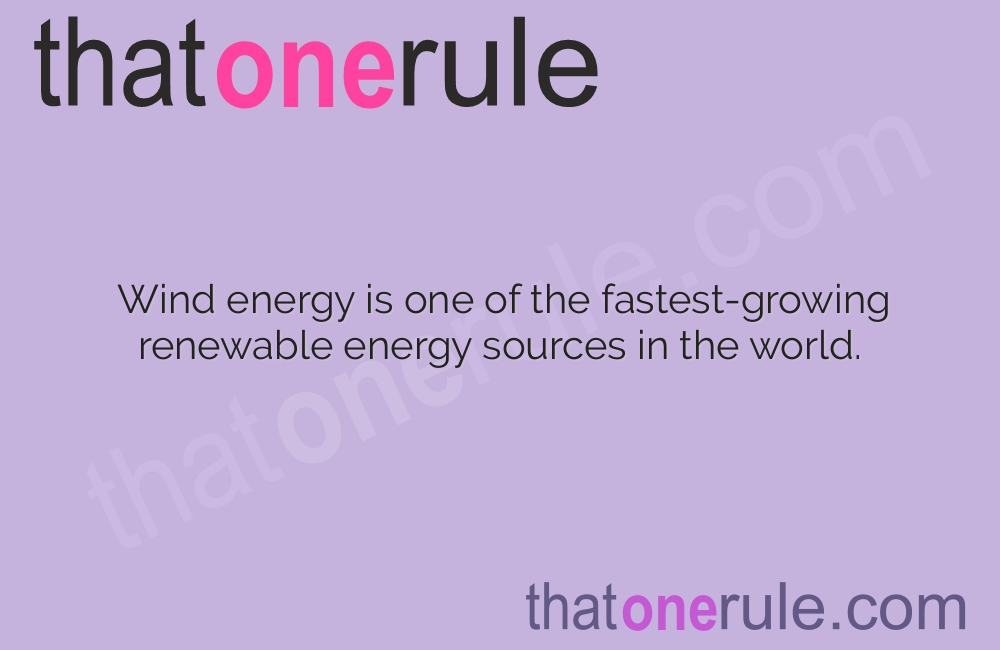Fascinating Facts about Wind Energy

Wind energy is one of the fastest-growing renewable energy sources in the world.
Wind turbines convert the kinetic energy of wind into electrical energy.
Wind energy is a clean and sustainable power source that does not produce greenhouse gas emissions.
Wind farms can generate electricity for thousands of homes and businesses.
Wind energy reduces our dependence on fossil fuels and helps combat climate change.
Large-scale wind farms can create job opportunities in construction, maintenance, and operation.
The first known use of wind energy dates back to 200 BC in Persia.
A single large wind turbine can power over 1,000 homes.
The world’s largest offshore wind farm, located off the coast of the United Kingdom, can power over 600,000 homes.
Wind energy can help reduce air pollution by offsetting the need for coal-fired power plants.
The blades of a wind turbine can spin at speeds of up to 200 miles per hour.
Wind energy can contribute to energy security by diversifying our energy sources.
Denmark is one of the leading countries in wind energy production, with wind turbines meeting around 50% of their electricity demand.
Wind energy has the potential to provide electricity to remote areas that are not connected to the grid.
Wind turbines have been used for pumping water, grinding grain, and sawing wood in the past.
Wind energy is abundant and inexhaustible, unlike fossil fuels.
Fascinating Facts about Wind Energy part 2
Offshore wind farms have the advantage of stronger and more consistent winds compared to onshore ones.
Wind turbines are relatively quiet, with noise levels comparable to a quiet office.
Wind energy has a lower life cycle carbon footprint compared to fossil fuels.
Wind turbines have a lifespan of around 20-25 years, after which they can be decommissioned and recycled.
Wind energy reduces the need for water consumption in electricity generation compared to traditional power plants.
Wind turbines typically require only a small land area, allowing for other land uses beneath or around them.
Wind energy can help drive economic growth by attracting investment and supporting local industries.
Wind energy can be harnessed in diverse settings, from mountainous regions to coastal areas.
Wind power is expected to provide around 20% of global electricity production by 20
Wind energy can be stored in batteries or converted into other forms of energy, making it flexible and versatile.
Wind farms can coexist with agricultural activities, allowing farmers to earn additional income.
Wind turbines have a high operational reliability and can withstand extreme weather conditions.
Wind energy does not contribute to water pollution, as it does not require water for cooling or fuel extraction.
Wind energy is a low-cost electricity generation option, with decreasing costs and increasing efficiency.
Wind turbines contribute to biodiversity preservation by occupying a relatively small space and allowing natural ecosystems to thrive.
Wind energy reduces the risks associated with fossil fuel extraction, such as oil spills and mining accidents.
Wind energy is a decentralized power source that can be produced on-site, reducing transmission losses.
Wind energy is not affected by fuel price fluctuations, providing a stable and predictable energy source.
Wind turbines can be installed in rural areas, revitalizing local communities and boosting tourism.
Wind energy can help countries meet their renewable energy targets and fulfill climate commitments.
Wind energy has a low water intensity, making it resilient to water scarcity and drought conditions.
Wind turbines have a high energy payback ratio, meaning they produce more energy than they consume during their lifetime.
Wind energy is a versatile power source that can be integrated into hybrid energy systems with solar, hydro, or geothermal energy.
Wind turbine technology continues to evolve, with larger and more efficient turbines being developed.
Wind energy reduces the health risks associated with air pollution from traditional power plants.
Wind turbines have become iconic structures in many landscapes, symbolizing efforts to transition to a cleaner energy future.
Wind energy provides a stable source of income for farmers and landowners through lease agreements for wind turbine installations.
Wind energy can help offset the environmental impacts associated with other forms of electricity generation.
Wind energy empowers individuals and communities to become active participants in the energy transition.
